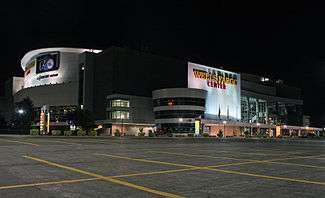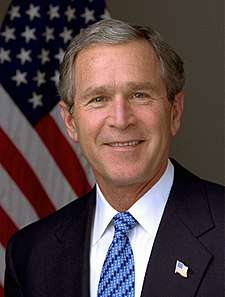2000 Republican National Convention
2000 presidential election | |
  Nominees Bush and Cheney | |
| Convention | |
|---|---|
| Date(s) | July 31 – August 3, 2000 |
| City | Philadelphia, Pennsylvania |
| Venue | First Union Center |
| Candidates | |
| Presidential nominee | George W. Bush of Texas |
| Vice Presidential nominee | Dick Cheney of Wyoming |
| Voting | |
| Total delegates | 4,335 |
| Votes needed for nomination | 2,172 |
| Results (President) |
Bush (TX): 4,328 (99.61%) Keyes (MD): 6 (0.29%) McCain (AZ): 1 (0.05%) Abstaining: 1 (0.05%) |
| Ballots | 1 |
The 2000 National Convention of the Republican Party of the United States convened at the First Union Center (now the Wells Fargo Center) in Philadelphia, Pennsylvania, from July 31 to August 3, 2000. The 2000 delegates assembled at the convention nominated Texas Governor George W. Bush for President and former U.S. Secretary of Defense Richard B. "Dick" Cheney for Vice President.
Political context

Bush, eldest son of the 41st president, was identified early as the party establishment's frontrunner and turned back a strong primary challenge from John McCain, a Vietnam War veteran and U.S. Senator from Arizona. At the convention, the party and campaign sought to showcase Bush's slogan of compassionate conservatism to persuade undecided voters.
Bush's acceptance speech
Bush attacked the eight years of the Clinton Administration as weak on defense and military topics, high taxes, underperforming schools and indifferent teachers, high pollution, and a "lack of dignity and respect to the presidency." He attacked the Clinton Administration's military policies, claiming that American troops were "not ready for duty, sir." He also claimed that the Clinton Administration did not provide leadership. He said, "They had their chance. They have not led. We will".
Roll call vote
Instead of holding the roll call of states on one night, the Bush campaign arranged for the voting to take place over four nights, so that Bush would eventually build up support throughout the week, culminating with Cheney's home state of Wyoming finally putting him over the top on the final night. There were few defections, despite a large contingent of delegates having been elected to support McCain, who formally released them to Bush.
| Republican National Convention presidential vote, 2000[1] | ||
|---|---|---|
| Candidate | Votes | Percentage |
| George W. Bush | 2,058 | 99.61% |
| Alan Keyes | 6 | 0.29% |
| John McCain | 1 | 0.05% |
| Abstentions | 1 | 0.05% |
| Totals | 2,066 | 100.00% |
The convention then voted by acclamation to make the convention nomination unanimous. Cheney's nomination as vice president had also been approved by acclamation on Wednesday night, so Cheney could address the convention later that night as the official nominee.
Speakers
July 31
- Colin Powell, former Chairman of the Joint Chiefs of Staff
- Elaine Chao, former president of the United Way of America and wife of U.S. Senator Mitch McConnell from Kentucky
August 1
- John McCain, U.S. Senator from Arizona
- Norman Schwarzkopf, Jr., retired general and allied commander during the 1991 Persian Gulf War
- Bob Dole, former U.S. Senator from Kansas and 1996 Republican Presidential Nominee
- George Pataki, Governor of New York
- Condoleezza Rice, professor of political science and former provost of Stanford University
- Laura Bush, school librarian and wife of George W. Bush
- Elizabeth Dole, former Secretary of Labor and wife of Former Republican Presidential Candidate Bob Dole.
August 2
- Lynne Cheney, former chair of the National Endowment for the Humanities and wife of Dick Cheney
- Vice Presidential nominee Dick Cheney, former U.S. Secretary of Defense
August 3
- Tom Ridge, governor of Pennsylvania
- Presidential nominee George W. Bush, governor of Texas
Other attendees
- Henry Bonilla
- Barbara Bush (Former First Lady)
- George H. W. Bush (Former President)
- George P. Bush (Son of George W.'s brother, Jeb Bush, Governor from Florida)
- Andrew Card (Former United States Secretary of Transportation)
- Robert Conrad
- Bo Derek
- Jennifer Dunn
- Gerald Ford (Former President)
- Bill Frist (Senator from Tennessee)
- Chuck Hagel (Senator from Nebraska)
- Melissa Hart (Congresswoman from Pennsylvania)
- Dennis Hastert (Speaker of the United States House of Representatives)
- Dwayne Johnson (The Rock)
- Lorrie Morgan (country music recording artist)
- Trent Lott (Senate Majority Leader)
- Sue Myrick
- Jim Nicholson (RNC Chairman)
- Nancy Reagan (Former First Lady)
- Richard J. Riordan
- Rick Schroder
- Ben Stein
- Connie Stevens
- Tommy Thompson (Governor of Wisconsin)
- Tom Patrick Waring (Editor of the Northeast Times)
- J.C. Watts
- Hank Williams Jr.
- Bruce Willis (Actor)
- Steve Young
Public Reception
In July 1999, the LGBT+ community of Philadelphia held two protests on July 29th & 30th. They did this in objection to Philadelphia hosting the Republican National Convention. [2]These protests resulted in the arrest of over 300 People.[3]
The initial protest was not target to the Republican Party specifically, rather, it was a call to change from both Republican and Democratic parties. The protesters felt that both political parties for the most part, ignored the needs and issues surrounding the LGBT community.[3]
See also
References
- ↑ "Republican Convention 2000". The Green Papers. Archived from the original on 6 October 2008. Retrieved 2008-10-29.
- ↑ August 1-7, 1999. Philadelphia Gay News, 1999, Special Collections Research Center, Temple University Libraries. Philadelphia, Pennsylvania.
- 1 2 August 8-14, 1999. Philadelphia Gay News, 1999, Special Collections Research Center, Temple University Libraries. Philadelphia, Pennsylvania.
External links
| Wikimedia Commons has media related to 2000 Republican National Convention. |
- George W. Bush's nomination acceptance speech for President at RNC (transcript) at The American Presidency Project
- Republican Party platform of 2000 at The American Presidency Project
- PBS Online NewsHour: Republican Convention 2000, archive including transcripts, analysis, interviews, photographs, and streaming audio/video.
- CNN AllPolitics: Republican Convention 2000, archived facts, news, speech transcripts, party platform, and links
- Rocca, Mo. Report From Philly: What's Wrong With Rabble Rousing? A Correspondent For "The Daily Show with Jon Stewart" Tried His Best To Ruffle Feathers At The Convention. A Web Exclusive By Mo Rocca. Newsweek.com. Aug 14, 2000.
- Video of Bush nomination acceptance speech for President at RNC (via YouTube)
- Audio of Bush nomination acceptance speech for President at RNC
- Video of Cheney nomination acceptance speech for Vice President at RNC (via YouTube)
- Audio of Cheney nomination acceptance speech for Vice President at RNC
- Transcript of Cheney nomination acceptance speech for Vice President at RNC
| Preceded by 1996 San Diego, California |
Republican National Conventions | Succeeded by 2004 New York, New York |
